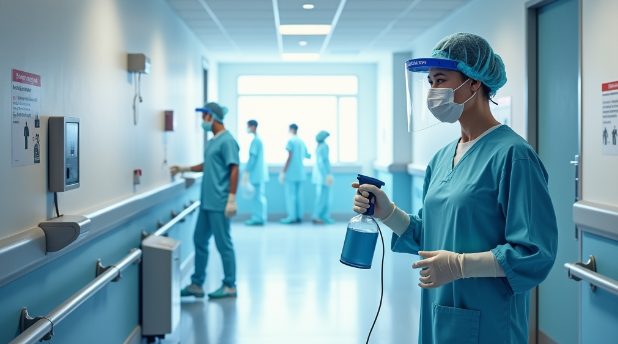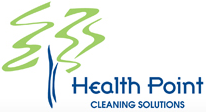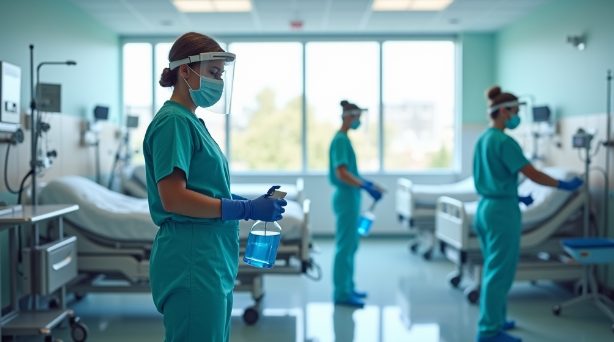Healthcare facility sanitization means keeping places like hospitals and clinics clean and safe. It is important for keeping germs away and making sure the environment is healthy for patients and staff. This guide will help you understand how to do this effectively.
Table of Contents
Key takeaways
- Sanitization is key to preventing the spread of disease.
- Regular cleaning keeps surfaces free of dirt and germs.
- Use the right disinfectants to kill harmful germs.
- Train staff on proper cleaning methods.
- Follow guidelines from health authorities like the CDC.
For further insights on maintaining health standards in facilities, explore best practices from local health services.
Understanding Healthcare Facility Sanitization

Sanitizing healthcare facilities is about more than just cleaning. It involves using specific methods to ensure that the environment is safe for everyone. This includes patients, visitors, and healthcare workers. By focusing on cleanliness, Healthcare Facility Sanitization can help stop the spread of infections.
Why is sanitization important?
Sanitization is crucial because it helps:
- Reduce the risk of infections
- Protect patients with weak immune systems
- Create a safe work environment for healthcare staff
In Phoenix, where healthcare facilities serve many people, keeping these places clean is vital. The warm climate can also mean more germs, so good sanitization practices are even more necessary.
The difference between cleaning and sanitizing
Cleaning removes dirt and grime. It involves using soap and water. Sanitizing goes a step further. It uses chemicals to kill germs on surfaces. In healthcare settings, both processes are important. First, you clean, and then you sanitize.
| Cleaning vs. Sanitizing | Cleaning | Sanitizing |
|---|---|---|
| Purpose | Remove dirt and grime | Kill germs on surfaces |
| Method | Soap and water | Disinfectants |
| Frequency | Daily or as needed | Regularly, especially in high-touch areas |
Key Steps for Effective Sanitization

1. Develop a cleaning plan
Every healthcare facility should have a written cleaning plan. This plan should outline:
- What needs to be cleaned
- How often to clean each area
- The methods and products to use
Having a clear plan helps ensure that every part of the facility gets the attention it needs.
2. Choose the right cleaning products
Using the right products is vital. Look for disinfectants that are effective against germs commonly found in healthcare settings. Products should meet the standards set by the Environmental Protection Agency (EPA).
In Phoenix, many suppliers offer products that are effective against local germs and are safe to use in medical settings.
3. Train staff on cleaning protocols
It’s not enough to have a plan and products. Staff must know how to use them. Training should include:
- Proper use of cleaners and disinfectants
- Personal protective equipment (PPE) guidelines
- Specific cleaning protocols for different areas (like waiting rooms or patient rooms)
4. Focus on high-touch surfaces
High-touch areas are places where many people come into contact. These include:
- Door handles
- Light switches
- Elevator buttons
- Waiting room chairs
Cleaning these surfaces frequently helps reduce the spread of germs.
5. Regular inspections
To ensure the cleaning plan is working, regular inspections are important. Managers should check areas to see if they meet cleanliness standards. This also helps staff stay accountable.
6. Use specialized cleaning methods
For certain areas, like operating rooms or isolation rooms, specialized cleaning methods may be necessary. These could include using steam cleaning or fogging techniques to disinfect the air and surfaces.
| Common Disinfectants | Active Ingredients | Targeted Germs | Contact Time |
|---|---|---|---|
| Bleach | Sodium Hypochlorite | Bacteria, Viruses | 10 minutes |
| Hydrogen Peroxide | Hydrogen Peroxide | Bacteria, Viruses, Fungi | 1-5 minutes |
| Quaternary Ammonium Compounds | Quaternary Ammonium Compounds | Bacteria, Viruses | 10 minutes |
Health Guidelines to Follow

Centers for Disease Control and Prevention (CDC)
The CDC provides guidelines for cleaning and disinfecting healthcare facilities. These guidelines are based on the latest research and should be followed closely.
Local health department regulations
In Phoenix, local health authorities may have additional requirements for sanitization. It’s important to stay informed about these regulations to ensure that your facility complies.
The Benefits of Proper Healthcare Facility Sanitization

Protecting patients and staff
Effective sanitization protects both patients and staff from infections. This is especially important in healthcare settings. Many patients have compromised immune systems and are more likely to get sick.
Improving patient satisfaction
When a facility is clean, patients notice. A clean environment can make patients feel safe and comfortable. This leads to higher satisfaction rates and better reviews.
Reducing healthcare costs
By preventing infections, proper sanitization can lower costs. Fewer infections mean fewer hospital stays and lower treatment costs. This can save money for both healthcare providers and patients.
- Enhanced safety protocols
- Better patient outcomes
- Increased staff morale
- Higher compliance with health regulations
Common Challenges in Healthcare Facility Sanitization
Staffing issues
Finding and retaining qualified cleaning staff can be a challenge. Training new staff takes time, and consistent cleaning is crucial.
Keeping up with the workload
Healthcare facilities can be busy, and it may be hard to keep up with the cleaning demands. Having a solid plan helps, but sometimes extra staff or time is needed.
Ensuring compliance
Compliance with cleaning protocols can be difficult. Regular training and inspections can help staff stay on track.
Real-life Experiences: Success Stories in Phoenix
In Phoenix, many healthcare facilities have adopted effective sanitization practices. Here’s what some have done:
- A local hospital implemented a new cleaning plan that included regular staff training. They saw a drop in infection rates over six months. This improved patient outcomes and satisfaction.
- A smaller clinic focused on high-touch areas and started using EPA-approved disinfectants. Patients reported feeling safer, and the clinic received positive feedback online.
For those looking for specialized cleaning services in healthcare, various local resources can provide tailored solutions.
Looking Ahead: The Future of Healthcare Facility Sanitization
As new diseases appear, sanitization methods will need to adapt. Technology in cleaning products and methods will continue to improve. In Phoenix, staying ahead of these changes is essential to ensure the health and safety of everyone in the community.
Emerging technologies
New cleaning technologies, like robots and UV light systems, are being developed. These can help sanitize areas quickly and effectively. As these tools become more available, healthcare facilities should consider adding them to their cleaning plans.
Ongoing education
As the healthcare landscape changes, ongoing education for staff will be key. Keeping up with the latest cleaning methods and standards will help maintain a safe environment.
Conclusion
Sanitizing healthcare facilities is essential. It keeps patients and staff safe from infections. By following best practices and staying informed, healthcare providers in Phoenix can create a cleaner, healthier environment. Remember to focus on cleaning plans, proper products, training, and high-touch surfaces. This will help protect everyone who walks through the doors of healthcare facilities in the community.
By prioritizing sanitization, we can ensure that our healthcare facilities remain safe and welcoming for all.
If you need help with healthcare facility sanitization in Phoenix, consider reaching out to Health Point Cleaning Solutions. They offer professional cleaning services tailored to healthcare environments. Feel free to visit our website or contact us for assistance.

